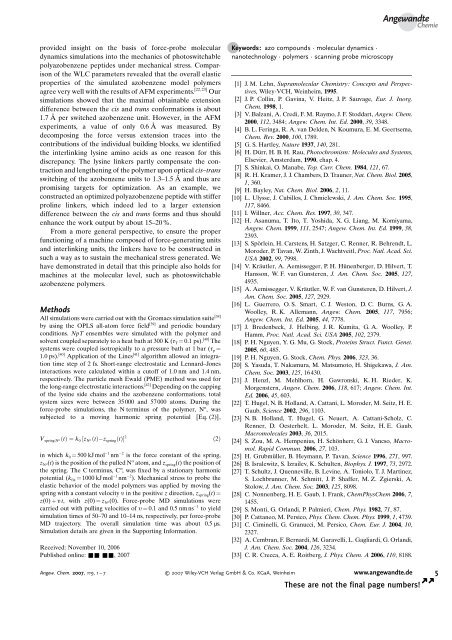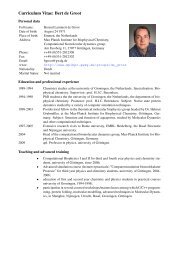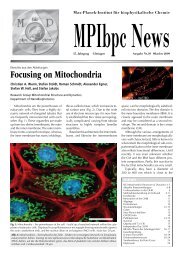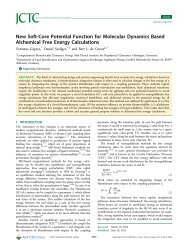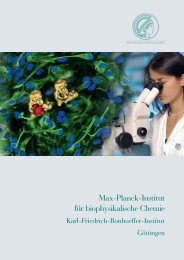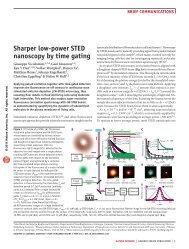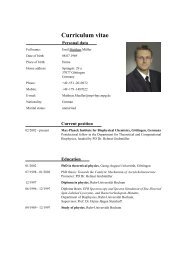Elastic Properties of Photoswitchable Azobenzene Polymers from ...
Elastic Properties of Photoswitchable Azobenzene Polymers from ...
Elastic Properties of Photoswitchable Azobenzene Polymers from ...
Create successful ePaper yourself
Turn your PDF publications into a flip-book with our unique Google optimized e-Paper software.
provided insight on the basis <strong>of</strong> force-probe molecular<br />
dynamics simulations into the mechanics <strong>of</strong> photoswitchable<br />
polyazobenzene peptides under mechanical stress. Comparison<br />
<strong>of</strong> the WLC parameters revealed that the overall elastic<br />
properties <strong>of</strong> the simulated azobenzene model polymers<br />
agree very well with the results <strong>of</strong> AFM experiments. [22,23] Our<br />
simulations showed that the maximal obtainable extension<br />
difference between the cis and trans conformations is about<br />
1.7 Š per switched azobenzene unit. However, in the AFM<br />
experiments, a value <strong>of</strong> only 0.6 Š was measured. By<br />
decomposing the force versus extension traces into the<br />
contributions <strong>of</strong> the individual building blocks, we identified<br />
the interlinking lysine amino acids as one reason for this<br />
discrepancy. The lysine linkers partly compensate the contraction<br />
and lengthening <strong>of</strong> the polymer upon optical cis–trans<br />
switching <strong>of</strong> the azobenzene units to 1.3–1.5 Š and thus are<br />
promising targets for optimization. As an example, we<br />
constructed an optimized polyazobenzene peptide with stiffer<br />
proline linkers, which indeed led to a larger extension<br />
difference between the cis and trans forms and thus should<br />
enhance the work output by about 15–20 %.<br />
From a more general perspective, to ensure the proper<br />
functioning <strong>of</strong> a machine composed <strong>of</strong> force-generating units<br />
and interlinking units, the linkers have to be constructed in<br />
such a way as to sustain the mechanical stress generated. We<br />
have demonstrated in detail that this principle also holds for<br />
machines at the molecular level, such as photoswitchable<br />
azobenzene polymers.<br />
Methods<br />
All simulations were carried out with the Gromacs simulation suite [38]<br />
by using the OPLS all-atom force field [39] and periodic boundary<br />
conditions. NpT ensembles were simulated with the polymer and<br />
solvent coupled separately to a heat bath at 300 K (t T = 0.1 ps). [40] The<br />
systems were coupled isotropically to a pressure bath at 1 bar (t p =<br />
1.0 ps). [40] Application <strong>of</strong> the Lincs [41] algorithm allowed an integration<br />
time step <strong>of</strong> 2 fs. Short-range electrostatic and Lennard–Jones<br />
interactions were calculated within a cut<strong>of</strong>f <strong>of</strong> 1.0 nm and 1.4 nm,<br />
respectively. The particle mesh Ewald (PME) method was used for<br />
the long-range electrostatic interactions. [42] Depending on the capping<br />
<strong>of</strong> the lysine side chains and the azobenzene conformations, total<br />
system sizes were between 35 000 and 57000 atoms. During the<br />
force-probe simulations, the N terminus <strong>of</strong> the polymer, N a , was<br />
subjected to a moving harmonic spring potential [Eq. (2)],<br />
V spring,N aðtÞ ¼k 0 ½z N a ðtÞ z springðtÞŠ 2<br />
in which k 0 = 500 kJ mol 1 nm 2 is the force constant <strong>of</strong> the spring,<br />
z N a(t) is the position <strong>of</strong> the pulled N a atom, and z spring(t) the position <strong>of</strong><br />
the spring. The C terminus, C w , was fixed by a stationary harmonic<br />
potential (k fix = 1000 kJmol 1 nm 2 ). Mechanical stress to probe the<br />
elastic behavior <strong>of</strong> the model polymers was applied by moving the<br />
spring with a constant velocity u in the positive z direction, z spring(t) =<br />
z(0) + u t, with z(0) = z N a(0). Force-probe MD simulations were<br />
carried out with pulling velocities <strong>of</strong> u = 0.1 and 0.5 nmns 1 to yield<br />
simulation times <strong>of</strong> 50–70 and 10–14 ns, respectively, per force-probe<br />
MD trajectory. The overall simulation time was about 0.5 ms.<br />
Simulation details are given in the Supporting Information.<br />
Received: November 10, 2006<br />
Published online: && &&, 2007<br />
ð2Þ<br />
Angewandte<br />
Chemie<br />
. Keywords: azo compounds · molecular dynamics ·<br />
nanotechnology · polymers · scanning probe microscopy<br />
[1] J. M. Lehn, Supramolecular Chemistry: Concepts and Perspectives,<br />
Wiley-VCH, Weinheim, 1995.<br />
[2] J. P. Collin, P. Gavina, V. Heitz, J. P. Sauvage, Eur. J. Inorg.<br />
Chem. 1998, 1.<br />
[3] V. Balzani, A. Credi, F. M. Raymo, J. F. Stoddart, Angew. Chem.<br />
2000, 112, 3484; Angew. Chem. Int. Ed. 2000, 39, 3348.<br />
[4] B. L. Feringa, R. A. van Delden, N. Koumura, E. M. Geertsema,<br />
Chem. Rev. 2000, 100, 1789.<br />
[5] G. S. Hartley, Nature 1937, 140, 281.<br />
[6] H. Dürr, H. B. H. Rau, Photochromism: Molecules and Systems,<br />
Elsevier, Amsterdam, 1990, chap. 4.<br />
[7] S. Shinkai, O. Manabe, Top. Curr. Chem. 1984, 121, 67.<br />
[8] R. H. Kramer, J. J. Chambers, D. Trauner, Nat. Chem. Biol. 2005,<br />
1, 360.<br />
[9] H. Bayley, Nat. Chem. Biol. 2006, 2, 11.<br />
[10] L. Ulysse, J. Cubillos, J. Chmielewski, J. Am. Chem. Soc. 1995,<br />
117, 8466.<br />
[11] I. Willner, Acc. Chem. Res. 1997, 30, 347.<br />
[12] H. Asanuma, T. Ito, T. Yoshida, X. G. Liang, M. Komiyama,<br />
Angew. Chem. 1999, 111, 2547; Angew. Chem. Int. Ed. 1999, 38,<br />
2393.<br />
[13] S. Spörlein, H. Carstens, H. Satzger, C. Renner, R. Behrendt, L.<br />
Moroder, P. Tavan, W. Zinth, J. Wachtveitl, Proc. Natl. Acad. Sci.<br />
USA 2002, 99, 7998.<br />
[14] V. Kräutler, A. Aemissegger, P. H. Hünenberger, D. Hilvert, T.<br />
Hansson, W. F. van Gunsteren, J. Am. Chem. Soc. 2005, 127,<br />
4935.<br />
[15] A. Aemissegger, V. Kräutler, W. F. van Gunsteren, D. Hilvert, J.<br />
Am. Chem. Soc. 2005, 127, 2929.<br />
[16] L. Guerrero, O. S. Smart, C. J. Weston, D. C. Burns, G. A.<br />
Woolley, R. K. Allemann, Angew. Chem. 2005, 117, 7956;<br />
Angew. Chem. Int. Ed. 2005, 44, 7778.<br />
[17] J. Bredenbeck, J. Helbing, J. R. Kumita, G. A. Woolley, P.<br />
Hamm, Proc. Natl. Acad. Sci. USA 2005, 102, 2379.<br />
[18] P. H. Nguyen, Y. G. Mu, G. Stock, Proteins Struct. Funct. Genet.<br />
2005, 60, 485.<br />
[19] P. H. Nguyen, G. Stock, Chem. Phys. 2006, 323, 36.<br />
[20] S. Yasuda, T. Nakamura, M. Matsumoto, H. Shigekawa, J. Am.<br />
Chem. Soc. 2003, 125, 16430.<br />
[21] J. Henzl, M. Mehlhorn, H. Gawronski, K. H. Rieder, K.<br />
Morgenstern, Angew. Chem. 2006, 118, 617; Angew. Chem. Int.<br />
Ed. 2006, 45, 603.<br />
[22] T. Hugel, N. B. Holland, A. Cattani, L. Moroder, M. Seitz, H. E.<br />
Gaub, Science 2002, 296, 1103.<br />
[23] N. B. Holland, T. Hugel, G. Neuert, A. Cattani-Scholz, C.<br />
Renner, D. Oesterhelt, L. Moroder, M. Seitz, H. E. Gaub,<br />
Macromolecules 2003, 36, 2015.<br />
[24] S. Zou, M. A. Hempenius, H. Schönherr, G. J. Vancso, Macromol.<br />
Rapid Commun. 2006, 27, 103.<br />
[25] H. Grubmüller, B. Heymann, P. Tavan, Science 1996, 271, 997.<br />
[26] B. Isralewitz, S. Izrailev, K. Schulten, Biophys. J. 1997, 73, 2972.<br />
[27] T. Schultz, J. Quenneville, B. Levine, A. Toniolo, T. J. Martinez,<br />
S. Lochbrunner, M. Schmitt, J. P. Shaffer, M. Z. Zgierski, A.<br />
Stolow, J. Am. Chem. Soc. 2003, 125, 8098.<br />
[28] C. Nonnenberg, H. E. Gaub, I. Frank, ChemPhysChem 2006, 7,<br />
1455.<br />
[29] S. Monti, G. Orlandi, P. Palmieri, Chem. Phys. 1982, 71, 87.<br />
[30] P. Cattaneo, M. Persico, Phys. Chem. Chem. Phys. 1999, 1, 4739.<br />
[31] C. Ciminelli, G. Granucci, M. Persico, Chem. Eur. J. 2004, 10,<br />
2327.<br />
[32] A. Cembran, F. Bernardi, M. Garavelli, L. Gagliardi, G. Orlandi,<br />
J. Am. Chem. Soc. 2004, 126, 3234.<br />
[33] C. R. Crecca, A. E. Roitberg, J. Phys. Chem. A 2006, 110, 8188.<br />
Angew. Chem. 2007, 119, 1 – 7 2007 Wiley-VCH Verlag GmbH & Co. KGaA, Weinheim www.angewandte.de<br />
These are not the final page numbers! Ü Ü<br />
5


